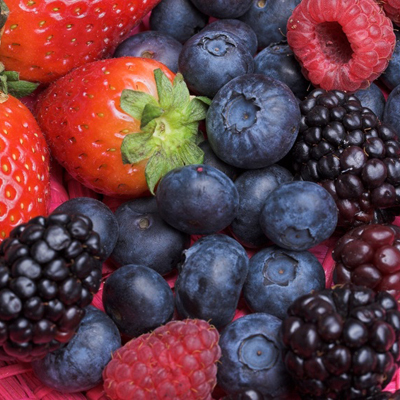Summertime Eating Healthy and Easy
Summertime Eating Berries From the Garden
Summertime eating means eating seasonally. With warm weather and summer approaching, I begin to consider the types of foods and menus that are appropriate for eating this time of year. Eating seasonally varies depending on where you live. I live in the Northeast, and so I enjoy four very different seasons. Seasonal cooking allows me to appreciate the freshest ingredients–and it’s a fact that fruits and vegetables grown near your home are generally healthier. Just consider the thousands of miles that produce from the West Coast has to travel before it arrives in the Midwest or East Coast.
This year I have joined a CSA — Community Supported Agriculture. I’ve met the farmer who grows the vegetables I will be eating this summer, and learned where and how my vegetables will be grown and harvested. Even if you don’t have the option of joining a CSA you probably have a farmer’s market in your area. Browse the market and be curious. Poke around the stands and notice what fruits and vegetables are available. Talk to the farmers—they will be able to tell you how they grow their produce. They will tell you if they use pesticides or follow more organic farming methods. Visiting the farmer’s market is the easiest way to determine what is seasonal where you live.
During the summer months I normally eat lighter fare. The weather is hot and humid, and I am looking to cool down my body. I am outside more in the summer and tend to be more active. During these months, there is an abundance of juicy fruits and vegetables sprouting from the earth. During the warm months of summer, I tend to eat foods that have higher water content like fruits, lettuces, tomatoes, watermelon, cucumbers and large leafy greens. I also eat more raw vegetables and more cracked grains. Raw foods and fruit generally have a cooling effect on the body. Fruits and vegetables are abundant during the summer, so that is a clue that you might consider eating a variety of summer fruits and veggies. Everyone needs to be responsible for their own food intake and decide which foods work best for them. Just remember that variety is the key to a healthy body—eat different foods each day—and experiment with your diet. You can learn to create healthy, balanced, and delicious meals wherever you live.
Summer Salad Recipe
Quinoa is an ancient grain from the Andes that is high in protein. It cooks quickly, is light and digestible and has a calming effect on the body. It is covered with an oily substance called saponin, so be sure to rinse it thoroughly before cooking–otherwise, it will taste bitter.
Take 1 ½ cups quinoa and rinse it several times under cold water. Dry roast the grain in a large, heavy-bottom fry pan until it is dry, stirring constantly. When the grains begin to turn golden and puff up add 3 cups of water. Bring this to a boil and add a pinch of salt. Cover the pan and simmer for approximately 20 minutes or until the water has evaporated and the quinoa is done. Remove the pan from the heat and fluff the quinoa with a fork. Place in a large bowl to cool.
While the quinoa is cooking, roast ¾ cup slivered almonds in a 325 degree oven until they are golden.
Slice 4 radishes into half moon circles. Slice 1/8 of a red onion into half moon circles. Finely chop ½ cup parsley.
Mix 2 tablespoons of red wine vinegar with 1 tablespoon of brown rice vinegar. Add salt and pepper to taste. Then whisk in ¼ cup olive oil.
Add the radishes, onions, almonds, ½ cup currants, and parsley to the cooled quinoa. Toss everything with the dressing. Taste and add salt and pepper if necessary.
Happy, healthy eating!
Frances Abrams
Guest Writer
Frances Abrams is a food and cooking coach. She has degrees in education and counseling and has completed programs in macrobiotics as well as natural cooking and integrative health. She meets with clients in person or by telephone. She can be reached at:


